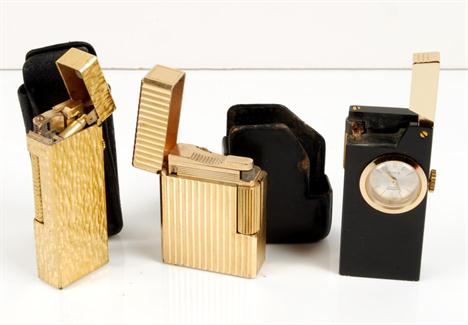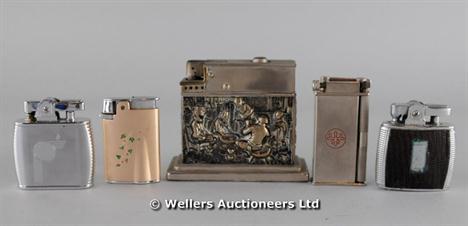We found 44568 price guide item(s) matching your search
There are 44568 lots that match your search criteria. Subscribe now to get instant access to the full price guide service.
Click here to subscribe- List
- Grid
-
44568 item(s)/page
Cartier - a gold plated lighter with original presentation box and flints, also a Victorian silver cigarette case, a 1965 Churchill crown mounted in silver pendant collar with a curb link chain; a silver curb link charm bracelet, fitted with approx 12 silver charms; a 9kt gold heart shaped pendant photo locket on chain; an Edwardian seed pearl set starburst design brooch and a further misc. collection of items. (a lot)
Two boxes of various Beatles ephemera to include an "Imagine" white painted metal piano table lighter and ashtray, an Invictor Plastics set of five plastic jewellery brooches as guitars, a wall clock "Strawberry Fields Forever", a Sgt. Pepper`s Lonely Hearts Club Band watch, wooden guitar shaped box, boxed, two Beatles clocks, a Fab Four battery operated clock, a plastic apple easel mirror, various John Lennon style round rimmed glasses, a black plastic vintage style telephone bearing central badge "Albert Dock The Beatles Story Liverpool", an Abbey Road in plastic guitar shaped case, a "Beatles For Sale" watch in black plastic guitar shaped box, a set of The Swingers party cake decorations and candle holders with original casing, a bag of Emirober Beatlemania plastic figures with Paul Macartney tag, another set with John Lennon tag, a set of four coal cast bronze figures of The Beatles, a Dora John Lennon guitar lighter, various keyrings, a Ludwig drum kit lighter, a "Peace" light ornament and a box for a "Yeah Yeah Yeah" CD player as a vintage record player (contents missing)
A Dutch bronze carronade, dated 1803, with pierced threaded pommel (for adjusting elevation) and securing ring to the moulded cascabel, aft and front sights to the tapered two-stage barrel terminating in a moulded muzzle with 7 inch bore, the base with integral cast trunnion ring, the barrel indistinctly cast with a ribbon inscribed ..AFSCHE REPBLIEK near the first reinforce and AMST. A. 1803 adjacent to vent hole, (erosion and wear to one side) 149cm long, 35cm maximum diameter. Provenance: The property of a private collector. Recovered from the wreck of an early 19th century Dutch East Indiaman off the west coast of Africa which was lost on a return trip from Batavia with a cargo including redundant cannon for smelting, the current lot was part of the operational armament of the vessel. Purchased directly from the salvers circa 1980. The carronade (named after the foundry in Carron, Scotland) was developed in around 1770 by the Royal Navy and had the advantages of providing increased firepower with a significant reduction in weight compared to standard muzzle loaders of the period. This was achieved by reducing the charge (typically rated the next calibre down from the bore) and improving the tolerances between the projectile and bore to reduce ÔwindageÕ. The result was a cannon which weighed around a quarter of the weight of the standard model of the same calibre however the range of the projectile was reduced to less than half. The carronade, due to its shorter barrel and lighter weight, also required a smaller gun crew. The Royal Navy soon realised that these advantages meant that the firepower on the upper decks of a vessel could be significantly increased by replacing smaller calibre long muzzle guns with carronades. This additional firepower became particularly advantageous during close quarter action particularly when grapeshot was employed to literally clear the decks. This, and the ability for the larger projectiles to create devastating splinters causing horrific wounds resulted in the carronade often being called the ÔmurdererÕ. The carronade was also ideal for deployment on merchant vessels as it provided an effective deterrent against close quarter action. The current lot was employed in this capacity on a vessel which was lost on a return leg from Batavia with a cargo including redundant bronze artillery for smelting. The inscription and date indicates that it was cast during the period of the Dutch Batavian Republic (1795-1806) when the Netherlands was essentially an annexe of the French Empire under Napoleon.
-
44568 item(s)/page



















































